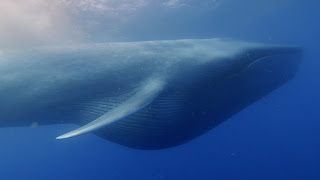"Faster
than a speeding bullet! More
powerful than a
locomotive! Able to leap tall buildings
at a single bound!"
No, wait: That’s the wrong script!
It should go this way: “Heart the size of a Volkswagen
Beetle! Jaws the height of a football
goal post! Aorta that a human could
crawl through!” And most dramatic: “The
largest animal in the world” -- in fact, “the largest animal to have ever lived
on earth!” -- yes, even larger than the dinosaurs.
 |
| Blue whale NYT pic |
It’s
“SuperWhale,” a.k.a. the blue whale. Part
of the baleen species (including right whales, humpbacks, etc.), it has
flexible protein plates (think bristles) hanging in rows from its upper jaws,
to filter food from sea water. Both their
baleen plates and two blow holes distinguish baleen whales from toothed whales
(with one blow-hole), the second of two basic suborders, which includes sperm
whales, orcas and all dolphins and porpoises.
Blue
whales can grow to about 100 feet (the largest ever measured was 109 feet long)
and can weigh around 160 tons. Newborn
“babies” are about 23 feet long and roughly 30 tons in weight.
 |
| Baleen whale NYT pic |
Aptly
called “leviathans” -- and sometimes regarded as sea monsters -- whales are
marine mammals of the order Cetacea,
along with dolphins and porpoises. Hard
as it may be to imagine, “the earliest whales . . . had four legs, a nose,
maybe even fur. They had bladelike teeth and lived in habitats that ranged from
woodlands with streams to river deltas, occasionally feeding in the brackish
waters of shallow equatorial coasts. And they were the size of a large dog.”
Not only did whales dramatically evolve from
terrestrial to sea creatures exclusively, but they also grew into the giants of
the sea we know now. One theory for that
relatively recent happening -- a mere 4.5 million years ago -- is spelled out
in the column cited above as well as the new book by the same author, Spying on Whales: The Past, Present, and
Future of Earth’s Most Awesome Creatures, by Nick Pyenson, curator of
fossil marine mammals at the Smithsonian Institution’s National Museum of
Natural History.
 |
| Humpback whale NOAA pic |
Presumably
obese, a local DJ claims he’s “living large and loving life.” Whales could agree with the first part of
that descriptor, but the second part’s iffy at best. Even though safely past the age of whale
hunts, great size still has risks that can prevent “loving life” -- or even
living it. Human-caused hazards include becoming
trapped by commercial fishing nets, collisions with ships, prevalence of PCBs
and garbage-choked seas, climate change and its effect on ocean temps and sea
life migrations.
And
at least in Japanese territorial waters, whales are still in great jeopardy. Long claiming scientific research as its
reason for hunting and slaughtering whales, Japan recently dropped out of the
pact designed to protect them so it could continue the slaughter.
https://www.nyt
imes.com/2018/12/31/opinion/editorials/japan-whale-hunt-whaling.html?em_pos=small&emc=edit_ty_20190101&nl=opinion-today&nl_art=3&nlid=20760274emc%3Dedit_ty_20190101&ref=headline&te=1
 |
| Orcas AP pic |
These
days, video stories abound of whales saving people from sharks and seeming to
show off their babies to humans, as well as “thanking” people who free them
from nets. Whale song has long been recorded
and analyzed, if not satisfactorily figured out.
Look! Down in
the sea: It's a boat, it's a sub -- it’s SuperWhale!
You cannot begin to preserve any species
of animal unless you
preserve the habitat in which it dwells.
Disturb or destroy that
habitat and you will exterminate the
species as surely as if you
had shot it. So conservation means that you have to
preserve
forest and grassland, river and lake, even the
sea itself.
--Gerald Durrell, naturalist
and author (1925-1995)
If you would like to comment on this blog post,
please go to 1moreonce.blogspot.com.
No comments:
Post a Comment